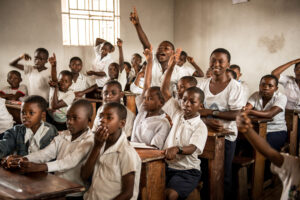
Six-month-old Gladys looks on, happily wide-eyed, as her mother rhythmically rocks the foot pedal of the sewing machine, skillfully passing the brightly colored ‘kikwembe’ fabric under the needle. Around Gladys’ seat near the door, her mother, Shukuru, and co-worker, Claudine, keep a steady, productive pace. The two young women maneuver around each other in the small workshop as they sew, attach snap buttons, skillfully cut fabric, and piece-by-piece construct beautiful clothes.
Shukuru is pleased with her new workshop and the work she is doing. She recently finished an apprenticeship in a shop across town, and is now able to try her own hand and artistry as a tailor in Goma’s Virunga neighborhood. Shukuru is one of 32 recent graduates from the Children’s Voice skill training schools. Like her other classmates, Shukuru learned the basics of the trade, spent three months as an apprentice in a workshop, and now is striving to succeed in her new space – which Children’s Voice helped to get on its feet. Sitting at her machine, she explained, “Its hard work, but I love sewing shirts, skirts, even pants.”
Children’s Voice, an ECI local partner, provides education for primary and secondary school children. Specializing in helping kids who have fallen behind due to financial or social problems, Children’s Voice supports a generation of Congolese children to get up to speed with their education. As a result, the classroom at Children’s Voice is a remarkably dynamic place. Order prevails until a question is launched, to which children enthusiastically wriggle in their seats, snapping wildly, hoping for the teacher to allow them to be the one to answer.
Recently however, Children’s Voice has expanded its definition of education, understanding that literacy and a state diploma are not the only things that help children and young adults to succeed. In response, the Children’s Voice team created sewing, hairdressing, and carpentry training programs for young men and women. The six-month vocational training program equips Goma’s youth with practical, employable skills, and the anticipation that the knowledge and experience will help them to take control of their economic future.
For many of the participating youth, like Shukuru, life has not always full of the steady hum of the sewing machine, the clanging of hammers, or the sharp edge cut of scissors, and the potential of productive business those sounds carry. She explained, “Before going through the training, life was difficult. In my big family, when there was food we ate, when there was not, we’d sleep instead.” For Shukuru, being a tailor is a way out of insecurity and into a future full of possibilities. Right now, she is focused on the dream of commanding a large workshop, staffed by a number of sewing and embroidering experts.
“Sewing is helping me to ready my future,” she explained. However, it’s not just her future it impacts. Such economic stability also reaches the next generation. Young Gladys doesn’t know it yet, but she has been graced with a bright future born of equally bright fabric. No matter whether Shukuru finds herself in a large shop, or still maneuvering around Claudine for space to cut and sew, for Shukuru there’s no doubt that either option will “help my child to grow well, to stay healthy, to study to any level she chooses.”
